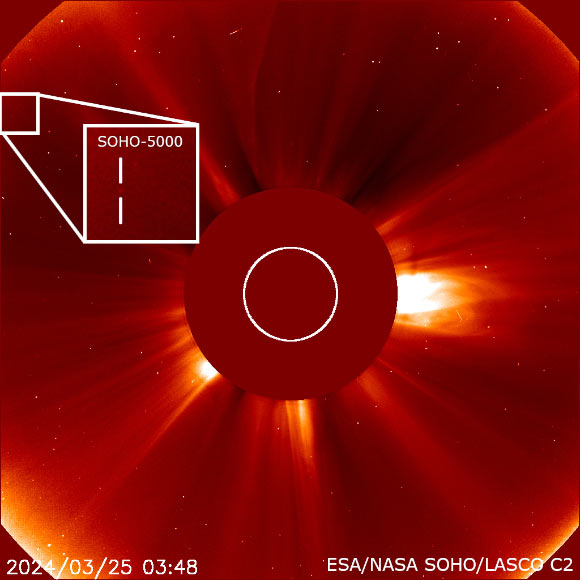On March 25, 2024, Hanjie Tan, an astronomy Ph.D. student in Prague, Czech Republic, spotted a comet in an image from the ESA/NASA Solar and Heliospheric Observatory (SOHO) spacecraft, which has now been confirmed to be the 5,000th comet discovered using the SOHO data. The observatory has achieved this milestone over 28 years in space, even though it was never designed to be a comet hunter.
SOHO-5000, the 5,000th comet discovered with SOHO spacecraft, is noted by a small white box in the upper left portion of this image. A zoomed-in inset shows the comet as a faint dot between the white vertical lines. The image was taken on March 25, 2024, by SOHO’s Large Angle and Spectrometric Coronagraph (LASCO). Image credit: NASA / ESA / SOHO.
A joint mission of ESA and NASA, SOHO launched in December 1995 to study the Sun and the dynamics in its outer atmosphere, called the corona.
The spacecraft’s Large Angle and Spectrometric Coronagraph (LASCO) instrument uses an artificial disk to block the blinding light of the Sun so scientists can study the corona and environment immediately around the Sun.
This also allows SOHO to do something many other spacecraft cannot — see comets flying close to the Sun, known as sungrazing comets or sungrazers.
Many of these comets only brighten when they’re too close to the Sun for other observatories to see and would otherwise go undetected, lost in the bright glare of our star.
While astronomers expected SOHO to serendipitously find some comets during its mission, the spacecraft’s ability to spot them has made it the most prolific comet-finder in history — discovering more than half of the comets known today.
In fact, soon after the spacecraft launched, people around the world began spotting so many comets in its images that mission scientists needed a way to keep track of them all.
In the early 2000s, they launched the NASA-funded Sungrazer Project that allows anyone to report comets they find in SOHO images.
“When LASCO was launched, no one had any idea that it would turn out to be the most prolific discoverer in history,” said U.S. Naval Research Laboratory researcher Dr. Karl Battams, the principal investigator of LASCO and the Sungrazer Project.
“The amount of data and science returned has just been beyond our wildest dreams.”
The 5,000th discovery was made by amateur astronomer Hanjie Tan from Guangzhou, China, who is currently an astronomy Ph.D. student in Prague, Czech Republic.
Tan has been participating in the Sungrazer Project since he was 13 years old, making him one of the project’s youngest comet discoverers.
He spotted the SOHO-5000 comet in the images from LASCO’s C2 camera.
Unlike most of SOHO’s comets, this comet very probably survived its passage by the Sun.
It will have passed approximately 8.2 million km (5.1 million miles) from the Sun — this is slightly farther from the Sun than the current orbit of NASA’s Parker Solar Probe.
“Since 2009, I’ve discovered over 200 comets,” Tan said.
“I got into the Sungrazer Project because I love looking for comets.”
“It’s really exciting to be the first to see comets get bright near the Sun after they’ve been traveling through space for thousands of years.”
SOHO-5000 is a small, short-period comet belonging to the Marsden group of comets, named for Dr. Brian Marsden who first recognized the group.
The Marsden group was not known to exist until SOHO/LASCO discovered it.
The group is believed to be ancient descendants of the near-Sun comet 96P/Machholz, which LASCO observes every 5.3 years.
Only approximately 75 of SOHO’s 5,000 comets belong to this comet group.
“The statistics of 5,000 comets, and looking at their orbits and trajectories through space, is a super unique dataset — it’s really valuable science,” Dr. Battams said.
“It’s a testament to the countless hours the project participants have put into this.”
“We absolutely would never had reached this milestone if it wasn’t for what the project volunteers have done.”




